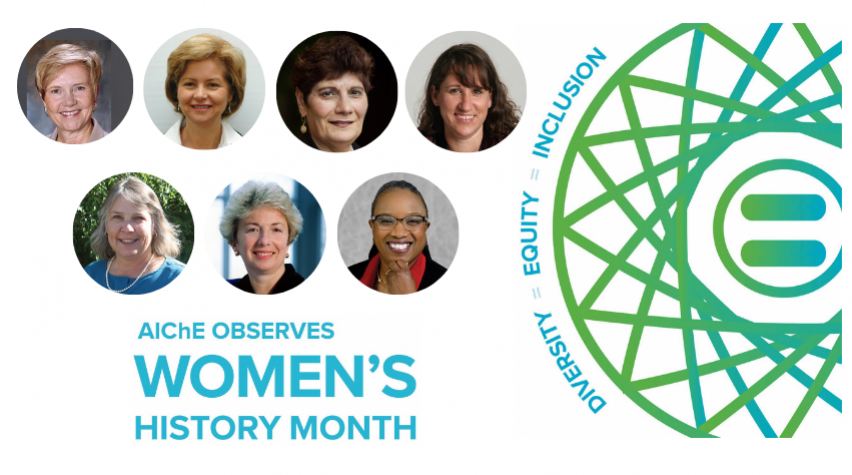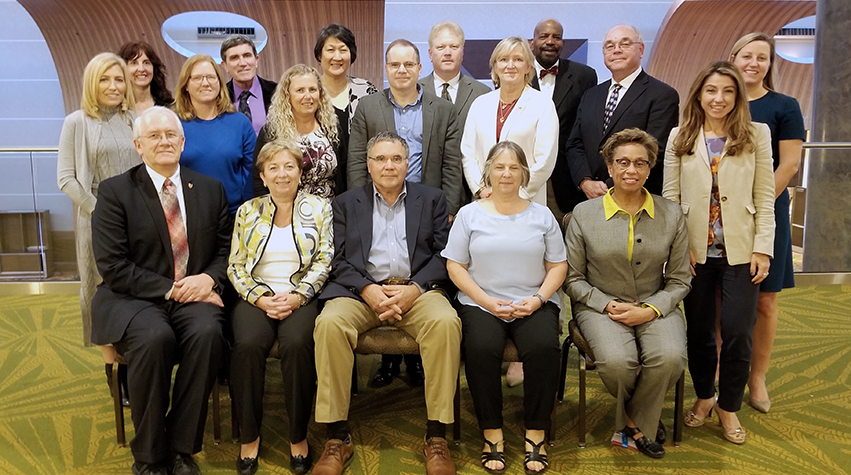
Women AIChE Presidents from left to right: Dianne Dorland (2003), Maria K. Burka (2011), Cheryl I. Teich (2015), Christine B. Seymour (2018), Kimberly L. Ogden (2019), Deborah L. Grubbe (2021), and Christine S. Grant (2022).
In 1983, as AIChE marked its diamond anniversary, the Institute published a book called 75 Years of Progress. The book detailed the evolution of the AIChE organization and community across decades of change. But here’s the remarkable thing: nowhere in the 180-page history will you find the name of a woman chemical engineer.
This stark absence reflected a reality of the time; prior to the 1970s, the number of woman chemical engineers on the AIChE member rolls was vanishingly small. In 1970, only 0.5 percent of AIChE members were women. But things were poised to change.
The continuing rise of women chemical engineers
The number of women receiving bachelor’s degrees in chemical engineering increased nearly a hundredfold between 1966 and 1986 (from 23 to 2,100) That population, of course, has continued to grow.
Along with this growth in women earning chemical engineering degrees, women were becoming more visible in the AIChE community. Still, at the time of the 75th anniversary in 1983, barely 6% of AIChE’s members were women, and only one woman chemical engineer had been elected to an Institute-level leadership role. That was in 1977, when Margaret P. Skillern, an engineer in Dallas, Texas, became a Board director. Nearly another decade would pass before more women were elected to the AIChE Board.
But women were emerging on the leadership scene. In 1980, Patsy S. Chappelear (another Texas-based chemical engineer) became the first woman to chair an AIChE technical division — the Fuels and Petrochemicals Division. Chappelear later became AIChE’s first woman Fellow. Starting in the mid-1980s, woman chemical engineers established a permanent presence on AIChE’s Board of Directors, becoming progressively more prominent into the 1990s and 2000s.
 A photo of AIChE’s 2020 Board of Directors. The emergence of women in AIChE leadership roles is clear.
A photo of AIChE’s 2020 Board of Directors. The emergence of women in AIChE leadership roles is clear.
Reaching the presidency
Dozens of women have since been elected to the AIChE Board, as directors, Institute secretaries, and treasurers. Seven have been elected AIChE President, beginning in 2003 when Dianne Dorland, Professor Emeritus and former Dean of Engineering at Rowan University, became the first.
Since then, six women have followed Dorland as AIChE President:
2011: Maria K. Burka, National Science Foundation; retired
2015: Cheryl I. Teich, Teich Process Development, Dow Chemical; retired
2018: Christine B. Seymour, Pfizer
2019: Kimberly L. Ogden, University of Arizona
2021: Deborah L. Grubbe, Operations and Safety Solutions, LLC
2022: Christine S. Grant, North Carolina State University; 2021 AIChE President-elect
A work in progress
In a January 2003 CEP magazine guest editorial, Dorland admitted her mixed feelings about the attention paid to her as the first woman AIChE president. “In some ways, it short changes my accomplishment in reaching this level of leadership,” wrote Dorland, “— as if my gender was a more important factor in my election than my years of experience as an engineer and my many contributions to AIChE.”
“Even more than that,” Dorland said, “in the twenty-first century, it’s a bit embarrassing that a woman holding such a post would be considered ‘news.”’ Dorland added that “while our journey to gender parity is not ended, we can at least measure some progress.”
In 2021, women at the head of AIChE’s leadership is no longer news.
Dorland did allow that her “first” gave her an opportunity to address an issue that she considered of critical importance at the time. “That is, the need to encourage diversity in all its forms, be it gender, ethnic background, physical challenges, orientation, or even the subtler differences of geographic regions. We need to encourage innovative problem-solving as we face the challenges ahead of us,” wrote Dorland.
She acknowledged that solving the problem would require partnerships between industry, universities, and associations like AIChE.
“It’s a tall order, but then again the stakes are quite high. Our profession and our nation are now at a crossroads. The challenges are greater, the resources are reduced. How can we hope to steer our way through this rough patch unless everyone’s oars are in the water?”
Dorland’s message is just as pertinent today as it was then.
This initiative is supported by the AIChE Foundation's Doing a World of Good Campaign.
AIChE Foundation – All for Good Campaign



